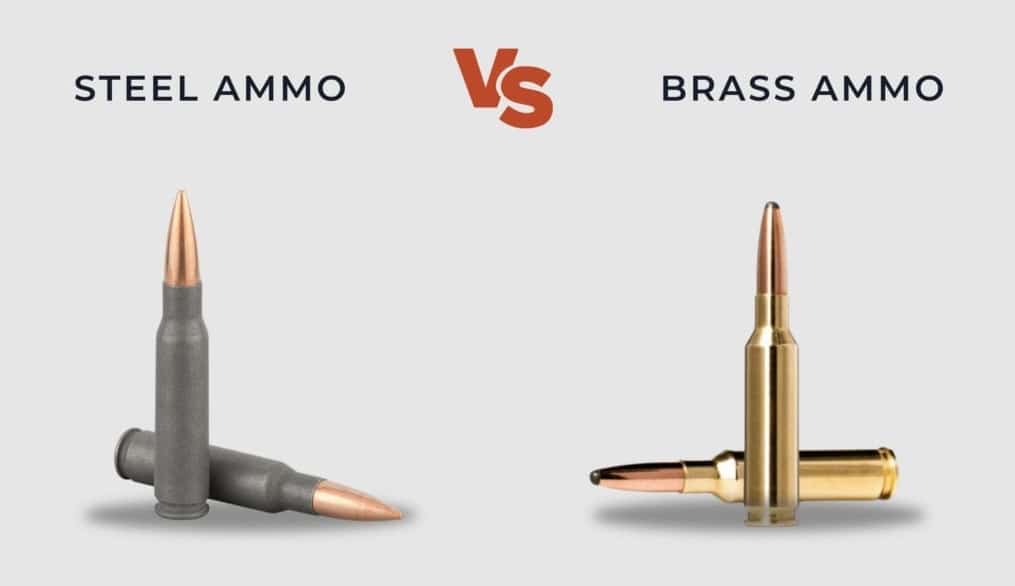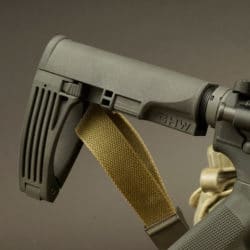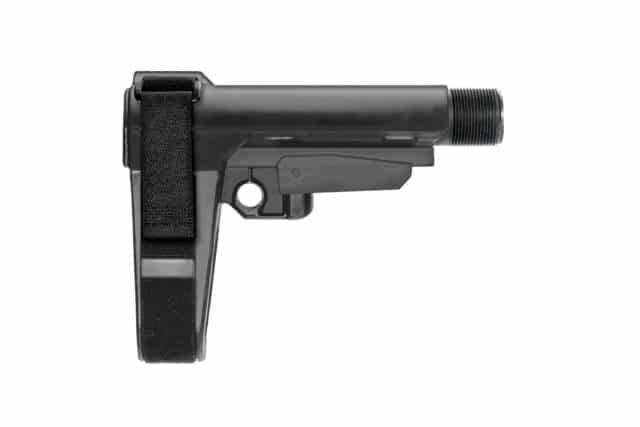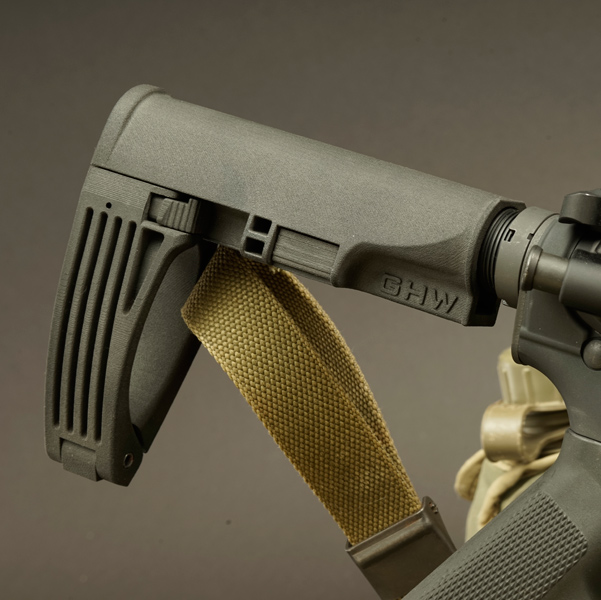By Mike Millsap
Ammunition is a crucial component in firearms, and its casing plays a significant role in
determining the overall accuracy, reliability, and longevity of the firearm. When it comes to
centerfire ammunition, two of the most common materials for casings are brass and steel.
While steel-cased ammunition has become a popular, lower-cost option, brass-cased
ammunition continues to dominate the market, especially among enthusiasts, military
personnel, and law enforcement agencies. This article explores the reasons why brass-
cased ammunition is considered superior to steel-cased ammunition in most
circumstances.
Introduction: A Brief Overview of Steel vs. Brass-Cased Ammunition
Ammunition cases, or shell casings, are an essential part of any centerfire cartridge. These
casings house the primer, powder, and projectile, and play a critical role in the firing
process. Historically, brass has been the material of choice for cartridge casings, but in
recent years, manufacturers have begun to use steel as a cost-saving alternative.
Steel-cased ammunition is often favored by budget-conscious shooters due to its lower cost
compared to brass. This is particularly evident in calibers like 9mm, .223 Remington,
7.63×39, and .308 Winchester, where steel-cased ammo is widely available. However, brass
casings have maintained their popularity for several key reasons, including better
performance, durability, and compatibility with a wider variety of firearms.
This article will examine the various factors that contribute to the superiority of brass over
steel, including reliability, performance, ease of reloading, and the overall impact on
firearm longevity.
Material Properties: Comparing Brass and Steel
To understand why brass is generally considered superior to steel for ammunition cases, it
is important to look at the fundamental properties of both materials.
Brass: Composition and Characteristics
Brass is an alloy composed primarily of copper and zinc. It is widely used in ammunition
casings because it possesses a combination of desirable mechanical properties:
• Ductility: Brass is highly ductile, meaning it can be easily shaped without breaking.
This makes it ideal for manufacturing smooth and reliable casings.
• Corrosion Resistance: Brass resists corrosion better than steel, making it more
durable in different environmental conditions.
• Strength and Elasticity: Brass is strong enough to withstand the pressure
generated during firing, but it is also elastic, which means it can expand and contract
without cracking or warping.
• Workability: Brass is relatively easy to machine and form into complex shapes,
making it ideal for mass production of ammunition.
Steel: Composition and Characteristics
Steel, on the other hand, is an alloy made primarily of iron and carbon, with additional
elements such as chromium and manganese. Steel offers several advantages in terms of
strength and hardness but also has some inherent limitations when compared to brass:
• Hardness: Steel is harder than brass, which makes it more resistant to wear.
However, this can be a double-edged sword when used in ammunition cases.
• Brittleness: Steel tends to be more brittle than brass. While it can be very strong, it
is more likely to fracture or crack under extreme pressure or stress.
• Corrosion: Steel is more prone to rusting than brass, especially if it is not properly
coated with a protective layer such as lacquer or polymer.
• Less Ductility: Steel is less ductile than brass, meaning it is harder to shape and
form into the precise specifications required for ammunition cases.
Reliability: How Steel and Brass Perform in Firearms
One of the most important considerations when comparing steel-cased and brass-cased
ammunition is their reliability in firearms. Reliability refers to how well the ammunition
functions during shooting and how often it causes malfunctions, such as jams, misfeeds, or
failures to eject.
Feeding and Ejection
Brass casings are more reliable in feeding and ejecting from firearms due to their ductility
and elasticity. Brass expands when fired, creating a tight seal with the chamber and
preventing gases from leaking around the casing. This results in consistent pressure and a
smoother firing cycle. After firing, brass contracts, allowing it to easily be ejected from the
chamber without binding.
Steel-cased ammunition, however, does not expand and contract in the same way as brass.
Steel is less elastic, so it may not form as tight a seal in the chamber. This can lead to the
“sticking” of the casing inside the chamber, especially in firearms that are not well-
maintained or have tight tolerances. In addition, steel casings are often coated with a
lacquer or polymer finish to prevent rust, which can create additional friction and make
feeding and ejection less smooth.
As a result, steel-cased ammunition is more likely to experience feeding issues and failures
to eject. These malfunctions can be frustrating for shooters, especially in high-stress
situations where reliability is paramount.
Firing Consistency
The consistency of firing is critical for accuracy and performance. Brass casings tend to be
more consistent in terms of dimensions and pressure tolerance. This consistency
contributes to reliable ignition and uniform firing behavior, which is essential for
maintaining accuracy and reducing the likelihood of jams or misfires.
Steel-cased ammunition, while generally reliable, may suffer from less consistency due to
the variations in steel alloy composition, the coating used, and the manufacturing process.
As a result, shooters may experience more variation in the performance of steel-cased
ammo, especially in long-range shooting or high-volume shooting environments.
Impact on Firearm Longevity
The longevity of a firearm is another critical consideration when choosing between steel
and brass-cased ammunition. Over time, repeated use of certain types of ammunition can
affect the wear and tear on a firearm, particularly the chamber and extractor.
Wear and Tear on the Chamber
Brass is more gentle on a firearm’s chamber because it expands and contracts smoothly
during the firing process. The elasticity of brass allows it to create a tight seal in the
chamber without causing excessive friction. This minimizes the wear on the chamber walls
and reduces the risk of excessive buildup of carbon or other residues.
Steel, due to its hardness and brittleness, can cause more wear on the chamber over time.
As steel expands less than brass, it may not form as tight a seal, which can lead to the
buildup of carbon and other debris in the chamber. In addition, steel casings are more
likely to leave behind small fragments of material during the extraction process, leading to
more frequent chamber cleaning and maintenance.
Extractor and Ejector Damage
Steel-cased ammunition can also cause more wear and tear on a firearm’s extractor and
ejector mechanisms. Because steel is harder than brass, it can create more friction during
the extraction process. This additional friction can increase the likelihood of extractor
damage or failure, especially in semi-automatic firearms that require frequent extraction
cycles. Over time, this can lead to malfunctions and more expensive repairs.
In contrast, brass is less abrasive and less likely to cause damage to the extractor or ejector.
As a result, firearms that primarily use brass-cased ammunition generally experience fewer
maintenance issues in these areas.
Reloadability: The Cost Advantage of Brass
One of the key advantages of brass-cased ammunition is its reloadability. Reloading
involves cleaning and reusing spent brass cases to create new rounds. This is an
economical option for serious shooters who go through large quantities of ammunition.
The reloading process also allows for greater customization of ammunition, including
changes in bullet weight, powder charge, and primer type, which can improve performance
and accuracy.
Steel-cased ammunition, on the other hand, is typically not reloadable. This is due to the
hardness of steel and the coatings often applied to the casings. The steel is more difficult to
resize and reform after firing, and reloading it can be more time-consuming and costly.
Additionally, the coatings used on steel casings can make it difficult to clean the cases
effectively, further reducing their viability for reloading.
For shooters who prioritize cost savings and are willing to put in the effort to reload, brass
is the clear choice. While steel-cased ammo is initially cheaper, it offers little long-term
value for reloading purposes.
Environmental Impact and Sustainability
Another important consideration is the environmental impact of brass vs. steel
ammunition. Brass is a recyclable material, which means that spent brass casings can be
collected and reused in the production of new casings. This makes brass a more sustainable
choice in the long term, especially for shooters who recycle their spent casings.
Steel is also recyclable, but it is less commonly recycled for ammunition production due to
the added complexity of removing coatings and other contaminants. Additionally, the
mining and processing of steel have a higher environmental footprint compared to copper
and zinc, which are used in brass. Therefore, while both materials have some
environmental impact, brass is generally considered to be a more eco-friendly option.
Conclusion: Why Brass-Cased Ammunition Is the Superior Choice
While steel-cased ammunition offers a more affordable initial cost, brass-cased
ammunition is the superior choice in terms of reliability, performance, firearm longevity,
and reloadability. The ductility, corrosion resistance, and consistency of brass make it ideal
for ammunition casings, while steel’s hardness and brittleness introduce several
challenges, including increased wear on the firearm, feeding and ejection issues, and
limited reloading potential.
For shooters who prioritize long-term value, reduced maintenance, and the ability to
reload their ammunition, brass remains the gold standard. While steel-cased ammunition
may serve as a budget-friendly option for casual shooters or those looking to shoot high
volumes of ammunition, it falls short when compared to the overall benefits of brass.
References:
• McPherson, G. (2008). Fundamentals of Firearm Ballistics. Paladin Press.
• Hatcher, J.S. (1935). Hatcher’s Notebook: A Manual of Firearms Knowledge. Stackpole
Books.
• Brownells. (2021). The Basics of Reloading Ammunition. Brownells Guides.
• Tann, S. (2014). The Science of Ammunition: Case Materials and Ballistics. Springer.




 By One Shot D and Erik Wenzel
By One Shot D and Erik Wenzel